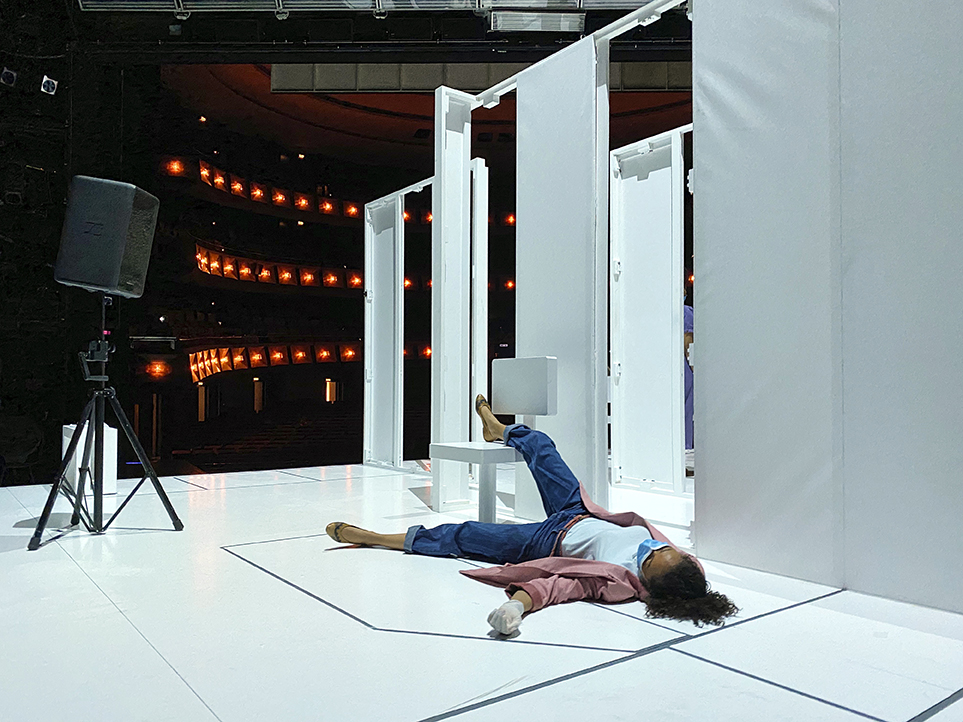
Art Tino Sehgal
A year at the Stedelijk 8/12: Ann Lee – The Casting of a Manga character.
Of all the constructed situations by Tino Sehgal shown at the Stedelijk Museum this year so far, ‘Ann Lee’ alienates the visitors the most. In a small room, an adolescent girl plays a Japanese Manga character brought to life. In a sweet voice, she announces that she is meeting humans for the first time. She slowly moves her limbs like the Star Wars robot 3-CPO and has a wondrous, inquisitive look in her eyes as she discovers the world for the first time. She is keen to communicate with the visitors and asks them remarkable questions such as “Would you rather feel too busy or not busy enough?” An awkward silence descends on the room as visitors are puzzled; are these questions are meant to be rhetorical or are they supposed to be answered?
Some girls are extremely convincing in playing Ann Lee on the verge of an artificial character and a human being. It’s amusing to experience the effect that her demeanour has on visitors. Some are intimidated by her and take a step back when she takes a step forward. Some are afraid to make eye contact with her when she asks them a question and they stare at their feet.
There is, however, a group of visitors who relish the alienation and play along. In a voice that is used when speaking to a child, they try to answer her questions, although the majority of the visitors are stumped by her last question, sounding more like a riddle, “What is the relation between a sign and melancholia?” She looks at each visitor individually and awaits an answer. When she doesn’t receive any response she says “Ok, take care” and shuffles out of the room.
 The room becomes dark and Philippe Parreno’s video “Anywhere Out of the World” is projected on the wall. A two-dimensional Manga character introduces herself as Ann Lee. Together with Pierre Huyghe, Parreno acquired Ann Lee’s copyright by paying 46000 Yen to a design character company called ‘K’ Works. Ann Lee explains how the trade in Manga characters works and says that some of the characters have the possibility of becoming a hero, but that was not Ann Lee’s destiny. “I was cheap. Designed to join any kind of story, but with no chance to survive,” she says disillusioned. After being sold, Ann Lee was redesigned and she shows an illustration of herself as an adorable, innocent child. Now she looks old and second-hand. Her attire is ordinary, her blue black hair look like it needs to be cut and her eyes are grey with no pupils, making her look like a ghost.
The room becomes dark and Philippe Parreno’s video “Anywhere Out of the World” is projected on the wall. A two-dimensional Manga character introduces herself as Ann Lee. Together with Pierre Huyghe, Parreno acquired Ann Lee’s copyright by paying 46000 Yen to a design character company called ‘K’ Works. Ann Lee explains how the trade in Manga characters works and says that some of the characters have the possibility of becoming a hero, but that was not Ann Lee’s destiny. “I was cheap. Designed to join any kind of story, but with no chance to survive,” she says disillusioned. After being sold, Ann Lee was redesigned and she shows an illustration of herself as an adorable, innocent child. Now she looks old and second-hand. Her attire is ordinary, her blue black hair look like it needs to be cut and her eyes are grey with no pupils, making her look like a ghost.
Parreno and Huyghe gave Ann Lee a second life by passing her onto other artists who created their own story lines for the character – free of charge. The project was called ‘No Ghost Just a Shell’ and ran from 1999 until 2003. Then, Parreno and Huyghe decided that the copyright of this fictional character be assigned to her so she no longer could be exploited. A lawyer in New York drew up an official contract.
Eight years later, Sehgal brought Ann Lee to life at the Manchester International Festival. She was part of the ‘11 Rooms’ group show, curated by Hans Ulrich Obrist and Klaus Biesenbach. The idea was to explore “the ephemeral nature of art through live art pieces”*
The casting of Ann Lee was done by Sehgal and one of his regular collaborators Asad Raza. There they found the ‘role model’ of Ann Lee, Nikita Broadbent, a fantastic interpreter of Ann Lee who performed the character at many locations around the world. “Nikita had a certain fragility and strength at the same time”, recalls Raza about the casting. “Also, what I liked about her was that when she spoke the lines she looked at me, Tino or the other people who were present in the room. She was really able to connect with each of us individually. I think that is very important as Ann Lee is staged in a small, intimate space where the girls really have to connect with each visitor in the room to make it work”.
Raza, who was also involved in the Dutch casting of Ann Lee, describes his role as the Director: in the sense that he cast the girls with Sehgal, trained them and set the piece in motion in Amsterdam for the first few days. Broadbent also came over and performed Ann Lee on the first day it opened at the Stedelijk Museum. She was also present at the rehearsals and showed the piece to the Dutch girls who were going to perform Ann Lee for the first time. “They had never seen it before and for them to be able to see Nikita performing Ann Lee was a major help”, Raza tells me. “She gave the Dutch girls some useful advice on how to play the animated character”.
Raza says that the casting process in Amsterdam was an open one. “We tried to find girls who are intelligent, who are comfortable with speaking to adults and are not overly theatrical. Generally, it does help if they study an instrument or take ballet or comedy classes as a certain discipline is required. They teach you how to use your body and your voice”.
Sehgal’s text for Ann Lee is intricately layered and each girl can give her own interpretation of the character. One interpreter evokes a feeling of pity when she tells the visitors that the artists who created her, Philippe and Pierre, became quite busy, inferring that they no longer had time for her anymore. Now with disappointment in her voice she says that Tino is also becoming quite busy. It reminded me of the heart breaking scene in ‘Artificial Intelligence’ when, David, a robot child capable of emulating thoughts and emotions, is abandoned in the forest by his adoptive mother. Again, Ann Lee becomes a product that is being discarded.
In Manchester, Sehgal’s Ann Lee was exhibited as a stand-alone, but showing it in conjunction with Parreno’s ‘Anywhere out of the World’ provides the visitors an intriguing back-story of the character. “The idea was developed after Philippe saw Tino’s version of Ann Lee in Manchester and he really connected with it,” Raza explains. “He wanted to include Tino’s Ann Lee in his exhibition at Palais de Tokyo in Paris in 2013 and his Park Avenue in New York earlier this year. So the two projects, Pierre and Philippe’s ‘Anywhere Out of the World’ and Tino’s ‘Ann Lee’ have merged. The idea was to express that in Amsterdam too and to show different ways of installing work”.
I ask Raza how Sehgal was able to secure Ann Lee’s copyright as the copyright was assigned to her. He laughs and says, “In the contract there wasn’t any mention made that the character couldn’t be brought to life. When I met the lawyer I told him that we have found a way to use Ann Lee for free. He answered, “Yes, you have found the loophole”.
Written by Thierry Somers
*Introduction by Alex Poots and Maria Balshaw, 11 rooms group show catalogue.










